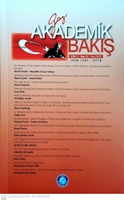Buhara Hanlığı ve Afganistan
The Khanate of Bukhara and Afghanistan
Author(s): M. Bilal ÇelikSubject(s): Modern Age, The Ottoman Empire
Published by: Gazi Akademik Bakış
Keywords: Bukhara Khanate; Baburids; Afghanistan; Safavids; Herat; Balkhash;
Summary/Abstract: The Khanate of Bukhara, which reigned between 1500 and 1920, was the longest surviving Turkish-Islamic State after the Ottoman Empire. The Khanate, founded in Ma Wara al-Nahr, had the opportunity to spread in the northern Afghanistan. The territory of Afghanistan was divided into three zones of influence after the complete dissolution of the Timurid Empire at the beginning of the 16th century.The west was under the control of the Safavid State, while the east was subordinated to the Baburid Empire. The northern part was dominated by the Khanate of Bukhara. As Muhammad Shibani Khan,the founder of the khanate, acquired Balkh in 1505 and Herat, the capital of Timurids, in 1507, he conquered a large part of the territory of Northern Afghanistan. However, with his death, although these lands were abandoned, the city of Balkh and its environs were subjected to the Khanate of Bukharaby Kistan Kara Sultan, son of Janibek, in 1526. Since then, Balkh has been one of the four main administrative regions of the Khanate of Bukhara, together with Bukhara, Samarkand and Tashkent.During the reign of Abdullah Khan II (1583-1598), Badakhshan, Qunduz, Talukan and Qulab were captured and the khanate borders were almost extended as far as Kabul. However, the dominance of the Khanate of Bukhara on the territory of Afghanistan has been fluctuating, and it has not been possible to keep it uninterruptedly. The longest ruled place became Balkh, especially during the reign of the Tuqai-Timurids (Astrakhanids, Janids). Here, the heir, relatively autonomous from the capital, has weakened quite the central administration. In this article, it will be discussed the Bukharan hegemony in Northern Afghanistan, and its conflicts with the Safavid State and the Baburid Empire from time to time in order to avoid losing that hegemony until Nader Shah seized Balkh in 1737 and Badakhshan in 1738.
Journal: Gazi Akademik Bakış
- Issue Year: 13/2020
- Issue No: 26
- Page Range: 327-354
- Page Count: 28
- Language: Turkish

